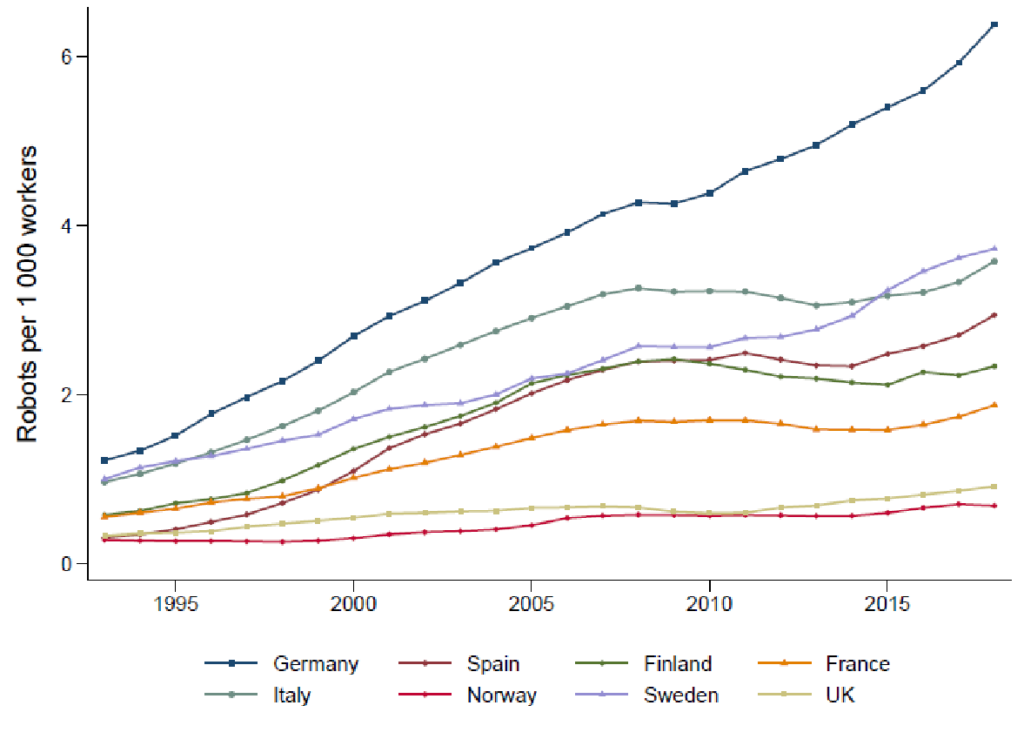A new empirical study examines whether advancements in automation and robotics have affected intergenerational income mobility. The authors find that parents’ exposure to new technologies is associated with lower income mobility.
The degree to which children are affected by parents’ labor market outcomes influences how children can shape their future. This concept is known as intergenerational mobility and measures the ability of children to achieve economic and social success regardless of their parent’s income or status. In a society with high intergenerational mobility, children of low-income parents have a greater chance of moving up the economic ladder. In contrast, children of high-income parents have less of an economic advantage. As such, intergenerational mobility plays a vital role in reducing inequality and improving the future well-being of children.
Intergenerational mobility has been an essential topic of research in economics for several decades, focusing mostly on income mobility. Studies from various countries have shown a strong correlation between parents’ and their children’s incomes. A high correlation implies low mobility across generations, which means that countries with high intergenerational transmission have lower economic mobility.
Recent research has focused on identifying factors that influence intergenerational income mobility. These include genetic factors, childhood access to education, residential segregation, and the effects of macroeconomic shocks, such as trade liberalization, parental job losses, and natural resource booms. However, it is still unclear how exposure to automation and the increased use of industrial robots, two of the most significant structural changes affecting labor markets in recent decades, have influenced intergenerational income mobility.
In a new study, we investigate whether the increasing use of automation technologies and robots has affected the economic mobility of children. Despite the extensive research on how new technologies have transformed labor markets, little is known about how they have shaped the economic outcomes of future generations. Many studies have shown that automation and robots have increased wage inequality and job polarization. Our study instead takes an intergenerational perspective and analyzes long-term effects on income mobility using detailed administrative population data from Sweden. This means we can study whether parental exposure to robots and software at the beginning of the 1990s impacts children’s adult outcomes and earnings almost three decades later.
In our analysis, we study exposure to automation at the occupational and industry-region levels to estimate separate effects for when parents are likely to have been adversely affected by automation and when parents are likely to have benefited from automation. At the occupational level, we look at robot and software exposure using two measures created by Webb (2020). These measures are based on the overlap between patent descriptions of new technologies and specific texts on job descriptions from the O*NET database developed by the U.S. Department of Labor. At the industry-region level, we use information on robot adoption from the International Federation of Robotics (IFR). These data include industry information on the stock of robots for over 20 countries and have been used in several recent papers on the impact of robotics.
Sweden is a suitable country to study the relationship between advances in automation technologies and intergenerational mobility, given that Sweden has been at the forefront of implementing new technologies. This is seen in Figure 1, which depicts the development of the stock of robots per 1,000 workers in eight European countries between 1993 and 2018. Only Germany has had a more significant increase in robot adoption during the last 25 years. Today, Sweden is top-ranked by the EU’s Digital Economy and Society Index and is ranked fifth globally and second in Europe on the list of installed robots per worker (IFR, 2021).

The impact of new technologies on the Swedish labor market is also apparent at the occupational level. For instance, evidence in Gardberg, Heyman, Norbäck, and Persson (2020) shows that the share of workers in occupations with high automation probabilities has decreased over time. This is illustrated in Figure 2, where occupational exposure to robots and software fell, on average, from 1996-2015 in Swedish firms.

When addressing the impact on intergenerational income mobility, we find that parents’ exposure to robots and software is negatively related to their children’s earnings and that higher exposure reduces earnings mobility across generations. To compare incomes across generations, we analyze parents’ and children’s income percentiles and focus on a rank-rank measure of income mobility based on the child’s position and the parent’s respective cohort distribution. Based on this approach, we present results showing that the rank-rank correlation is more than 10% higher if the parent was in a high-exposed profession instead of in a low-exposed occupation.
Comparing intergenerational income mobility between children with parents in high- and low-exposed occupations is problematic if other underlying differences impact income mobility but have nothing to do with automation and investments in robots. For instance, automation and investments in new technologies have typically affected routine-intensive occupations in the middle of the income distribution. Therefore, to identify the causal impact of automation and robot adoption on intergenerational income mobility, we apply a shift-share instrumental variable approach and use exogenous regional and industry variation in robot penetration. This method helps us to isolate the impact of automation and allows us to analyze whether income mobility differs depending on whether parents worked in high- and low-exposed occupations in high- and low-exposed industry-regions. Doing that, we show that the negative impact of occupational exposure on intergenerational mobility in earnings originates from industry-regions with a relatively large increase in robot adoption. In other words, income mobility is significantly lower if the parent had a high-robot-exposure occupation in these industry-regions. We do not find such a relationship in industry-regions with low robot adoption, supporting the idea that our estimates capture the effect of automation.
Overall, based on various specifications, our results suggest that automation and robot adoption has dampened intergenerational income mobility. This means that children of parents in industries and regions with high exposure to automation may have a more challenging time moving up the income ladder than children of parents in sectors and areas with low exposure to automation.
To further shed light on the long-term effects of automation, we explicitly analyze upward mobility, defined as the probability that the children of low-income parents reach the top income quartile. Our findings here indicate that children with parents highly exposed to robots at both the occupational and the industry-region levels have been less likely to reach the top-income quartile than children with low-exposed parents. We also document that the negative impact of parental exposure to automation on children’s expected earnings is twice as large among low-income parents than high-income parents, suggesting that automation may have affected overall inequality through an intergenerational channel. Finally, we show that children are more likely to be worse off as adults in several dimensions if their parents are exposed to new technologies – as measured by unemployment risk, being out of the labor force, going into early retirement, and living on social benefits.
Our new research suggests that automation and technological advancements impact intergenerational mobility. This reveals a new channel in which technological changes affect our society beyond just creating new jobs and changing the nature of work. These effects can be long-lasting and have important policy implications. It is, therefore, essential to consider how these structural changes can be addressed to minimize their negative impact on intergenerational mobility.
Articles represent the opinions of their writers, not necessarily those of the University of Chicago, the Booth School of Business, or its faculty.






